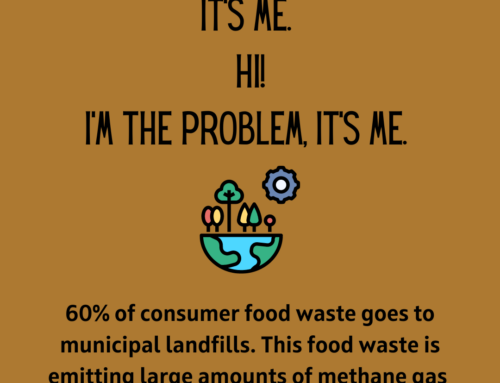Veal. When was the last time you bought it and cooked it, or ordered it at a restaurant? If your answer is “It’s been years”, I encourage you to give it a try, because it is delicious.
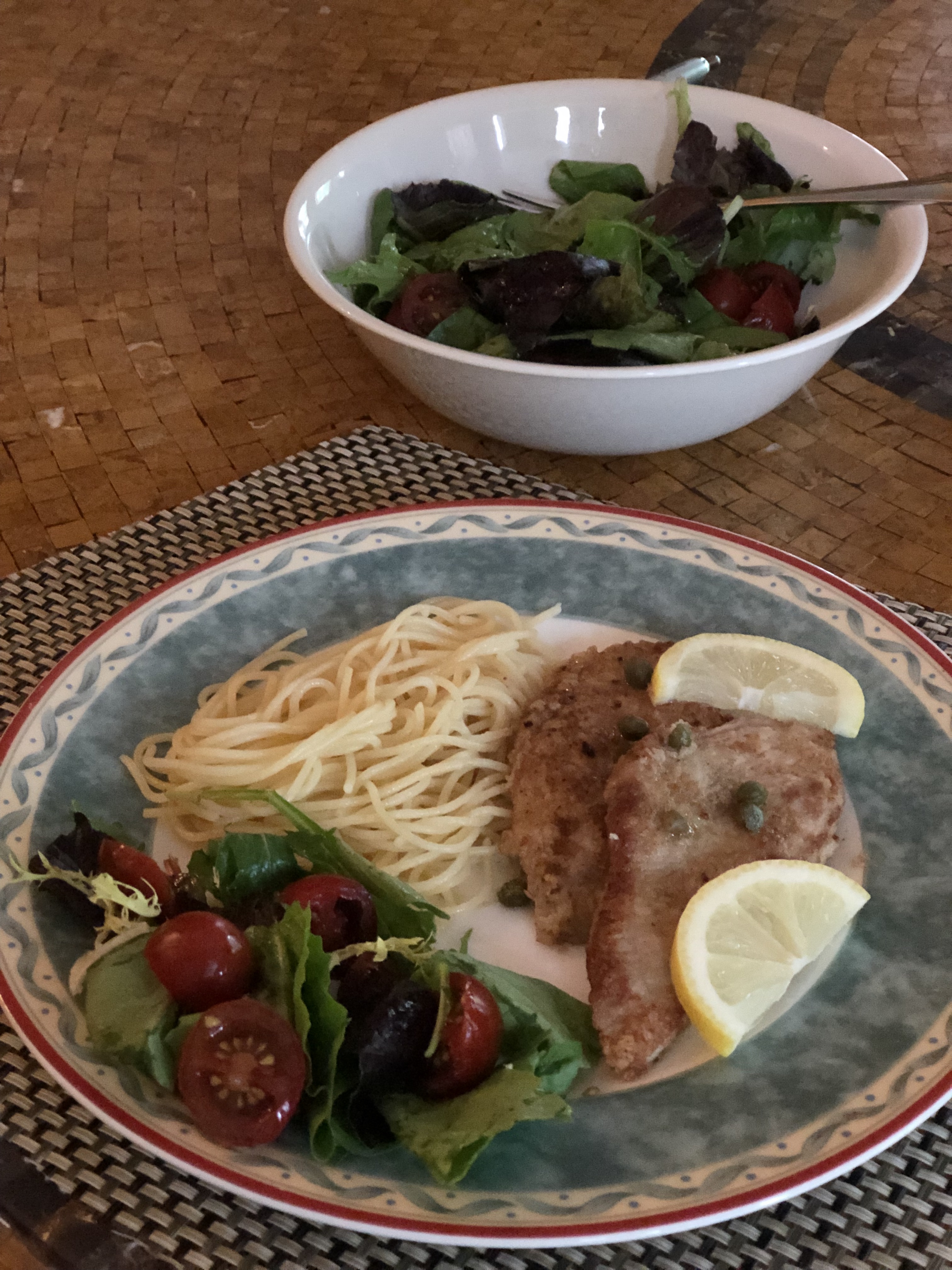
Veal Piccata – A delicious meal your family will love.
I had the opportunity to attend a sponsored press trip where I visited three veal farms – two in Pennsylvania and one in Indiana. The central Pennsylvania farms produce veal at Marcho Farms, a family owned and operated business since 1969 who work with an Amish community of farmers. We had the opportunity to meet with the farmers, their families, the farm’s nutritionist, and the Calf Procurement manager (responsible for purchasing and scheduling the delivery of calves into barns and to processing).
In Indiana, we toured Philip Ramer Farm, and met the veterinarian (Dr Marissa Hake – follow her on Instagram @VealVet), the President of Strauss Veal Feeds, and the President of Midwest Veal. The Strauss family has been in the feed business for over 100 years, and they founded Midwest Veal in 1975.
I’ve got news for you – veal farming has changed!
Where Does Veal Come From?
Veal comes from male (bull) calves born to dairy cows. Dairy cows are mostly Holstein cows. After they give birth, dairy cows go right back to milking. Female calves stay on the dairy farm and go to the calf barn. Male calves are procured to veal farms. At that point, the veal farmers take over care for the calves (which may be anywhere from 4 days to 10 days old when they arrive at the farm). To ensure their safety, young calves are kept in their own individual pen when they arrive to their new home, until around 4 weeks.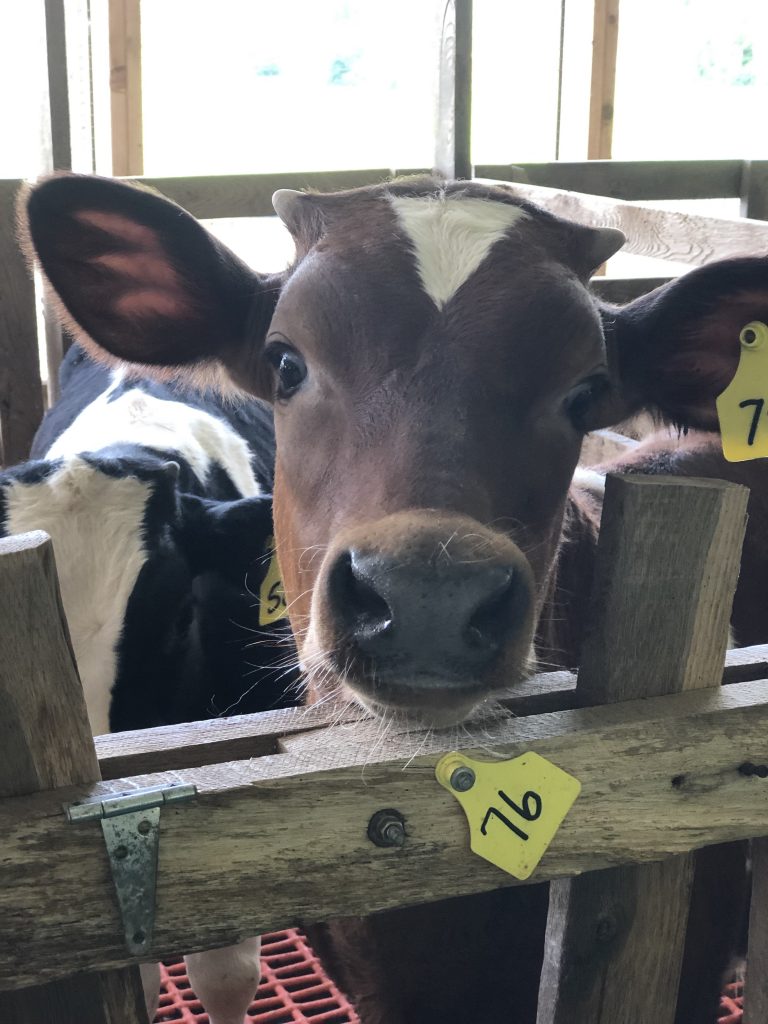
Animal Welfare
Farmers care about their livestock, from start to finish. You may be surprised to learn that many of the thoughts you have about veal are misconceptions. Over the years, farmers have worked to create a more humane industry that also produces a quality product.
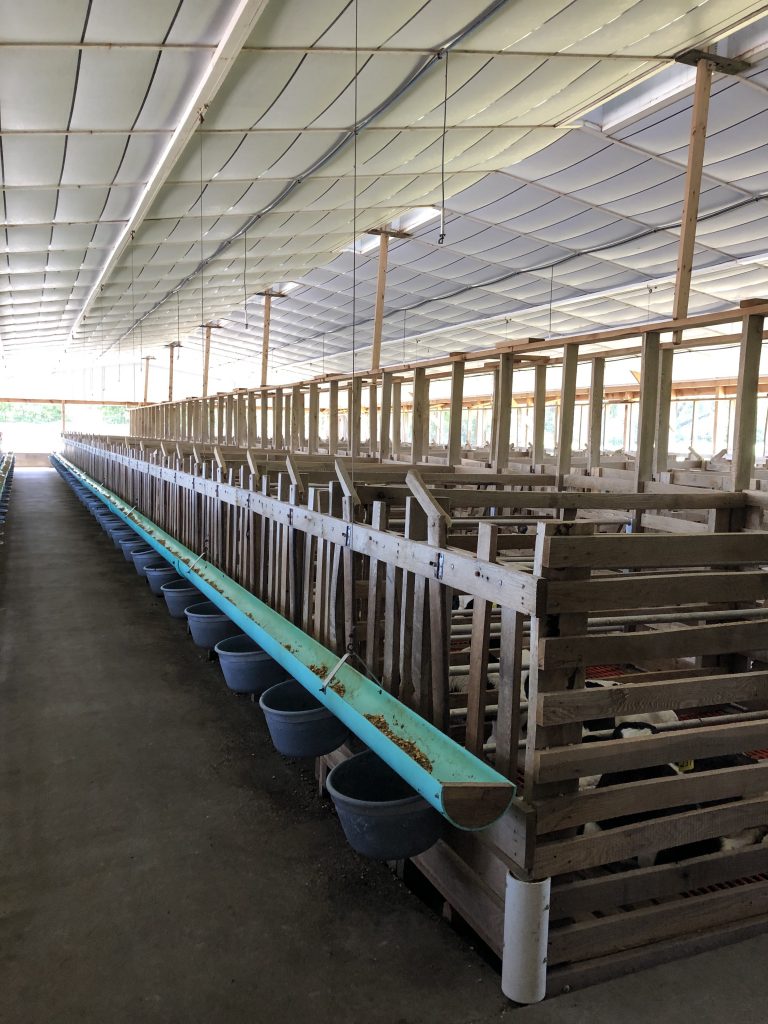
This is a Pennsylvania veal barn. Calves here are 4 weeks old. They are kept in single stalls for monitoring, and then moved to pairs or groups after 4 weeks.
Farmers work with a team of experts, including animal nutritionists and veterinarians, to manage nutrition and the everyday well-being of calves carefully. Images you may have of animal abuse, or visions of little baby calves, does not depict how most veal is raised. The majority of the veal on the market is from a 6 month old, 500 pound calf, produced on farms similar to the ones we visited. At these farms, the animals are not chained. They are in large temperature-controlled barns with good air circulation and natural sunlight, where they can move around freely.
Let’s address some commonly asked questions:
Why aren’t the cows grown for beef? Veal calves come from Holstein cows, not Angus like most beef cattle. They could be grown for beef, but it wouldn’t be the best product. It’s more efficient to utilize the male calves for veal.
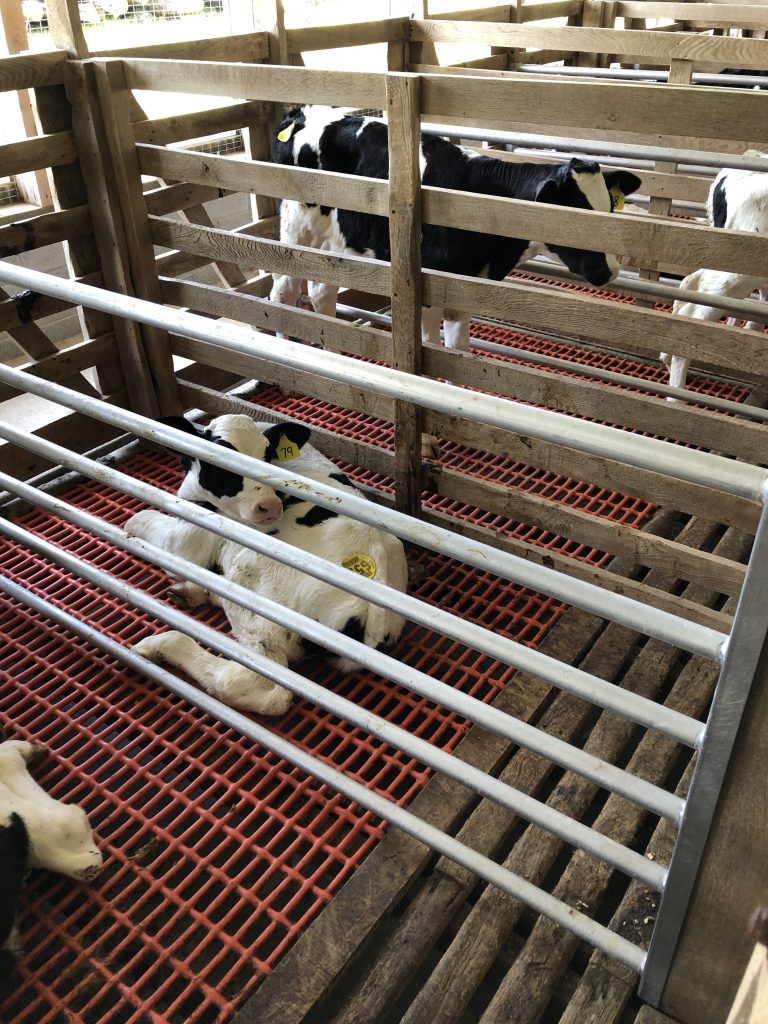
Young calves are monitored in single stalls (large enough to move around in) until about 4 weeks, at which time they are placed in pairs or in larger group stalls with room to move.
Are hormones or antibiotics in veal? No. Veal farmers do not use any hormones (it’s illegal). All veal at the market is antibiotic free. Even if a sick animal needs an antibiotic, the FDA requires a specific withdrawal period, and there can be no antibiotic residue left when the veal is processed.
Are these animals really “milk fed”? Yes. Strauss Veal Feeds supplies food for Midwest Veal raises veal at about 60 farms throughout Indiana, Michigan and Ohio, but each farm I visited develops their own feed specific to raising mild fed veal calves. It’s very similar to human infant powdered formula, and mixed with water. The formulated powdered milk (using whey from the dairy farm, and adding other nutrients) provides excellent nutrition to the calf. This a very sustainable way to use our dairy supplies to provide healthy nutrition to the calves.
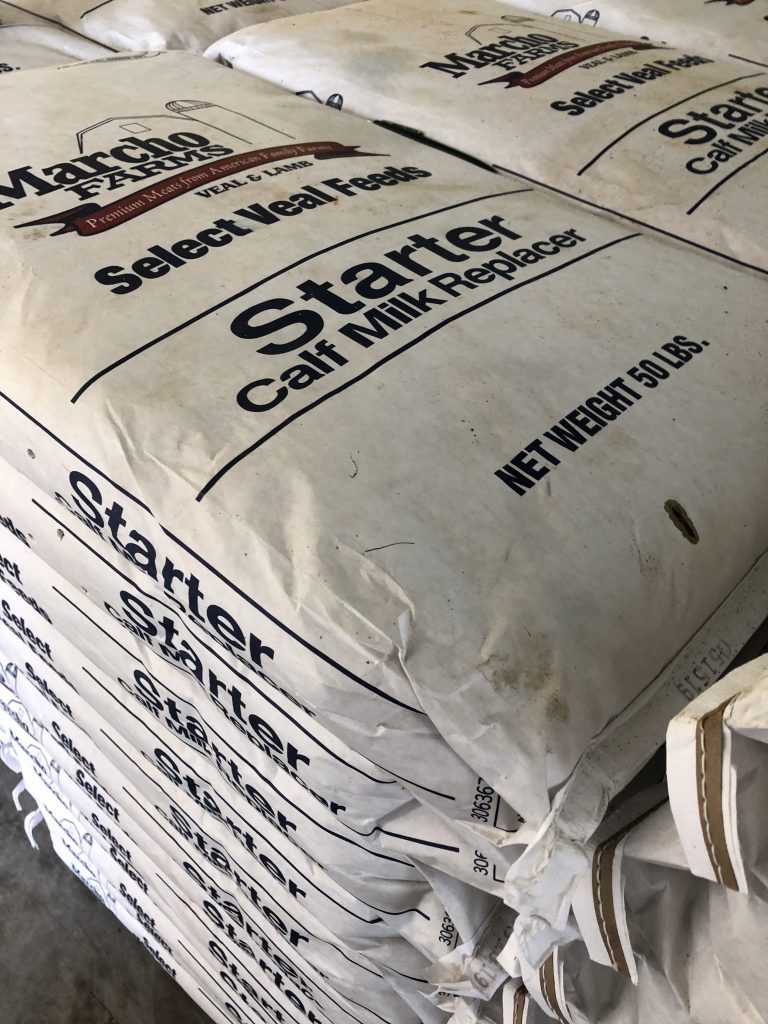
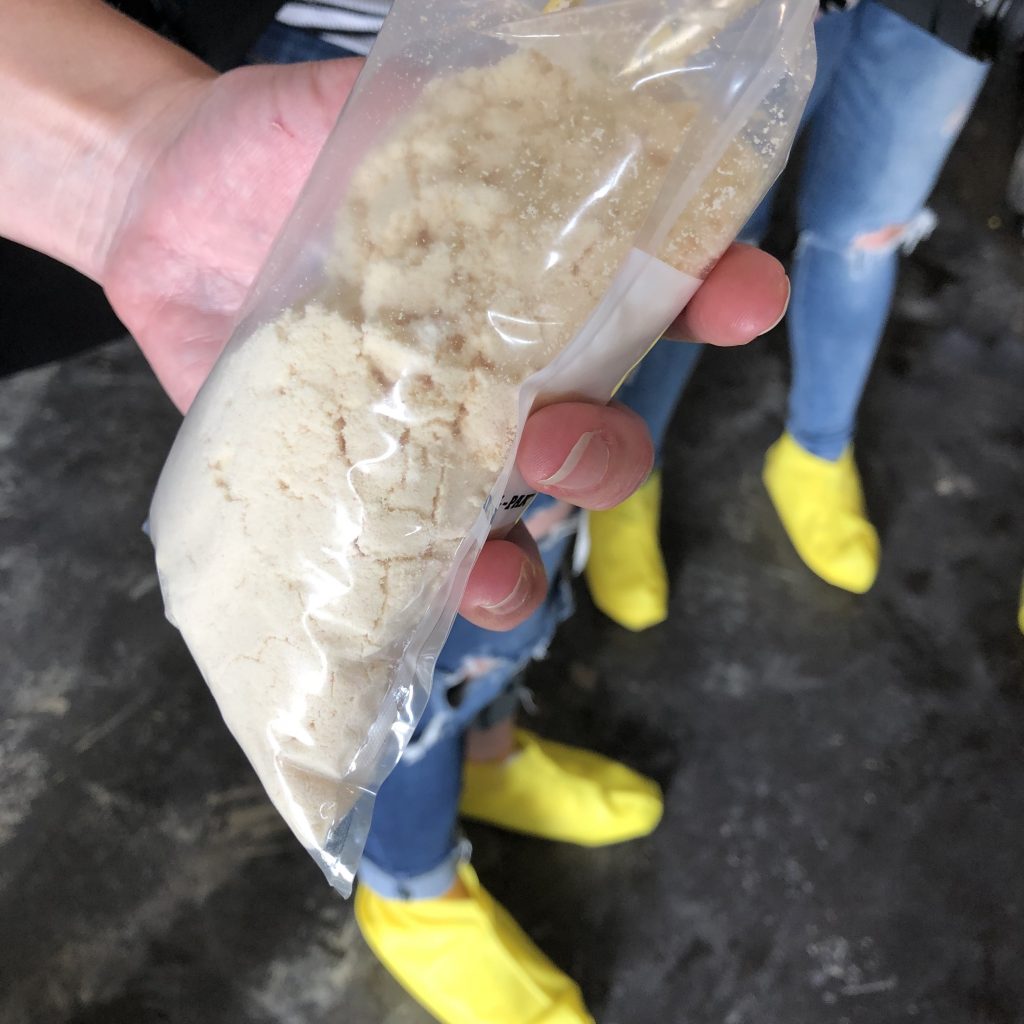
This photo shows the powdered formula from the Indiana farm
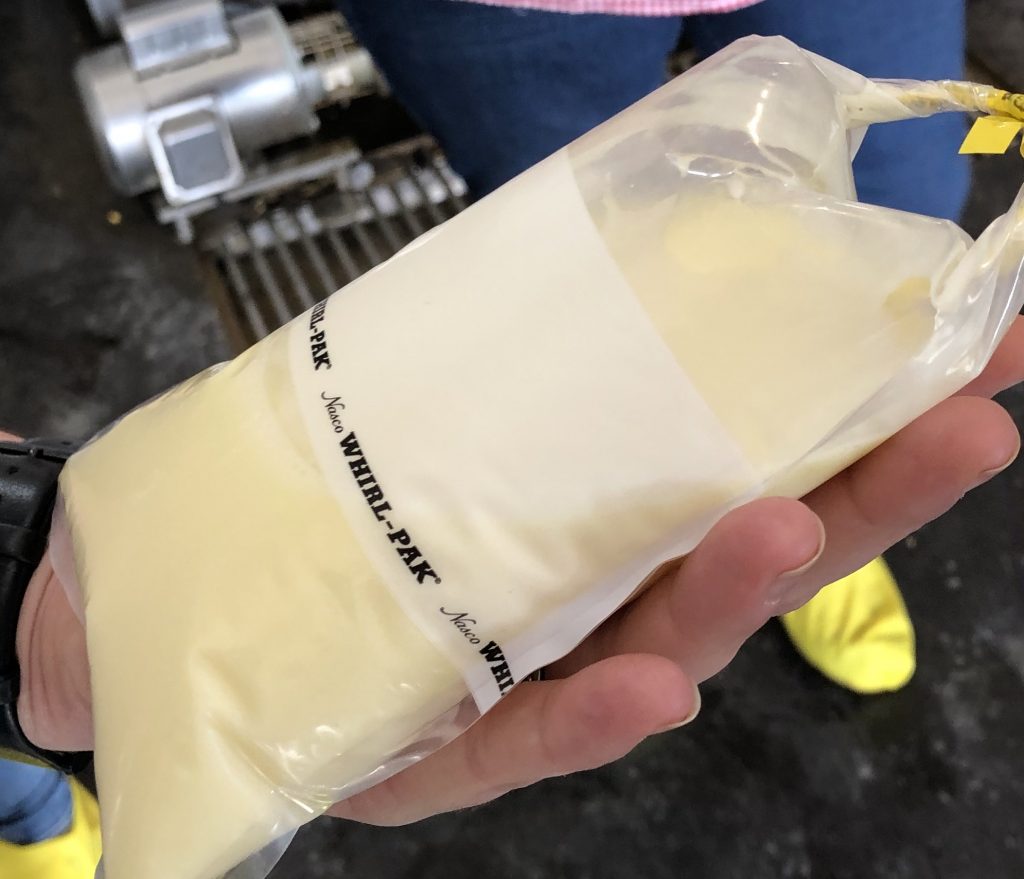
This is the formula mixed with water – which is how it’s delivered to the calves in their drinking troughs.
Are veal calves anemic? No. Calves are given an iron supplement by the vet when they get to the veal farm. And, each calf is tagged. These tags tell the farmers and vets exactly which farm the calf came from. They use this tag identity to track their age, origin, and health markers, so they can provide specific care.
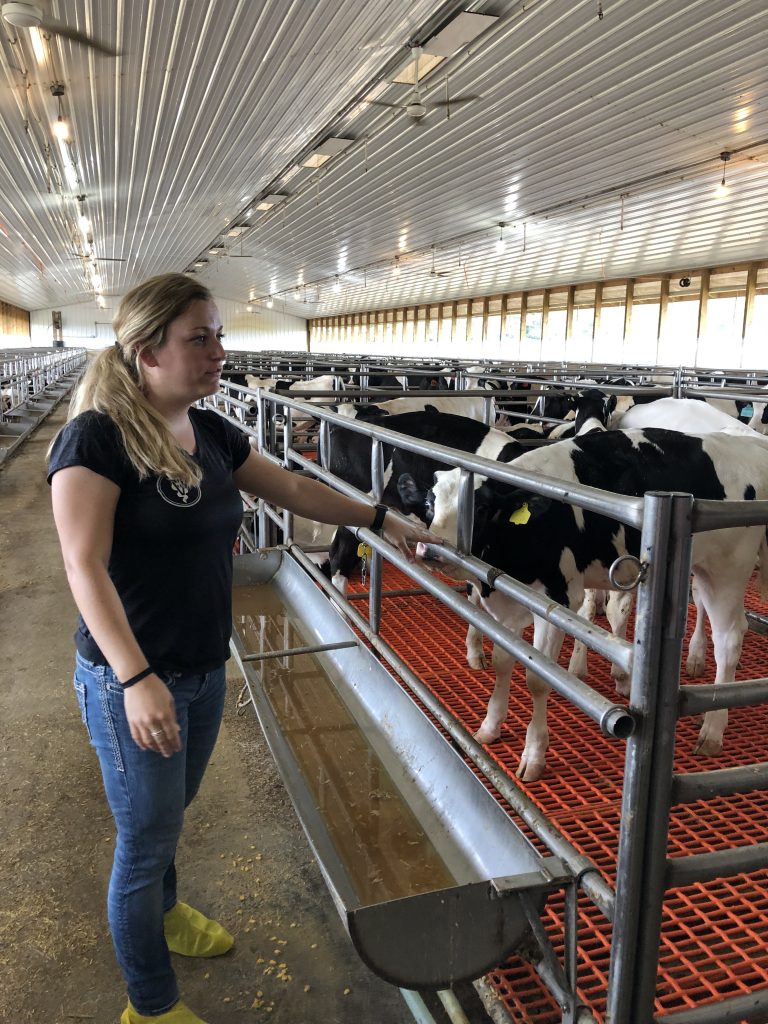
Veterinarian, Dr. Hake, explains how the calves are cared for. They gain 2-3 pounds a day, and are 150 pounds at 4-5 weeks, 350 pounds at 14 weeks, and 450-500 pounds at 20-24 weeks old.
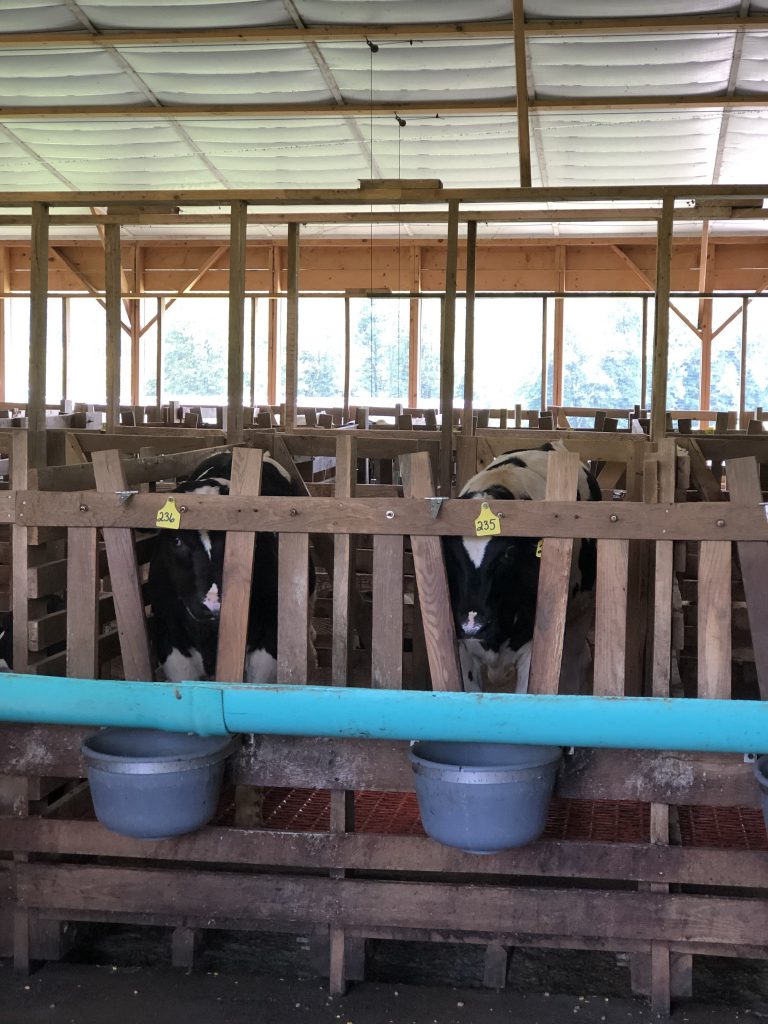
Calves are started with a milk formula twice a day, and water, the first 2 weeks. They continue on the twice-daily milk formula but are also given a high protein grain mixture to snack on (corn barley, soybeans, and a protein/starch pellet (made from whey, spent grain and wheat).
Are calves kept tethered in pens? Calves aren’t kept in small pens any longer. They are housed in large, open-air barns. The barns protect them from harsh weather and allow farmers to feed and water them regularly.
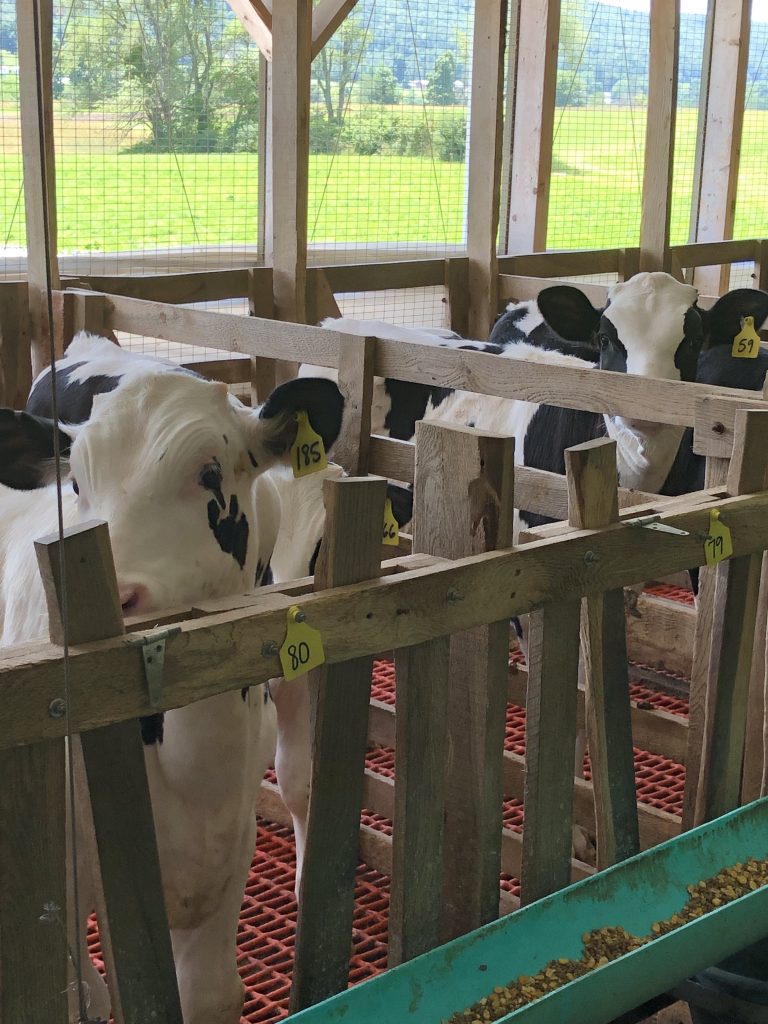
4-week old calves are paired up in open air barn in Pennsylvania
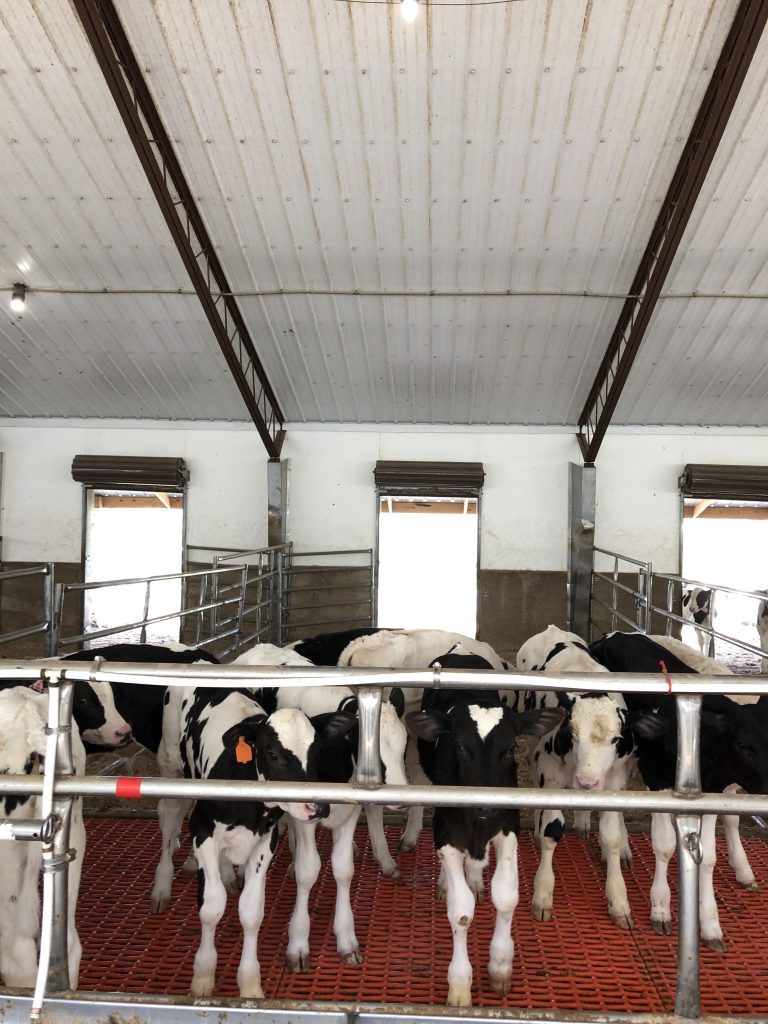
The lit doorways you see behind the calves are open doors they can walk through to get outside. They seem to prefer the cool barn for the most part.
Aren’t the calves uncomfortable being penned up? The calves are very content to be in the barn together. The space keeps them safe and clean, and allows the vet to quickly see if any of them are in distress. Each stall allows for room to turn around, lay down, and socialize. On the Indiana farm, calves moved to a larger barn where they could move outside into an open area, and back to the covered stall, as they wanted. Still, they mostly like to herd together. These barn systems also allow the farmer to keep their stalls clean, and manage manure. Manure is one of the components in animal agriculture that contributes to greenhouse gas. By using barns with open stalls, the manure is collected and contained, and then used to formulate natural fertilizer, which is applied to the area fields to grown crops. Keeping the calves in barns also allow the Veterinarians to monitor the health and wellbeing closely.
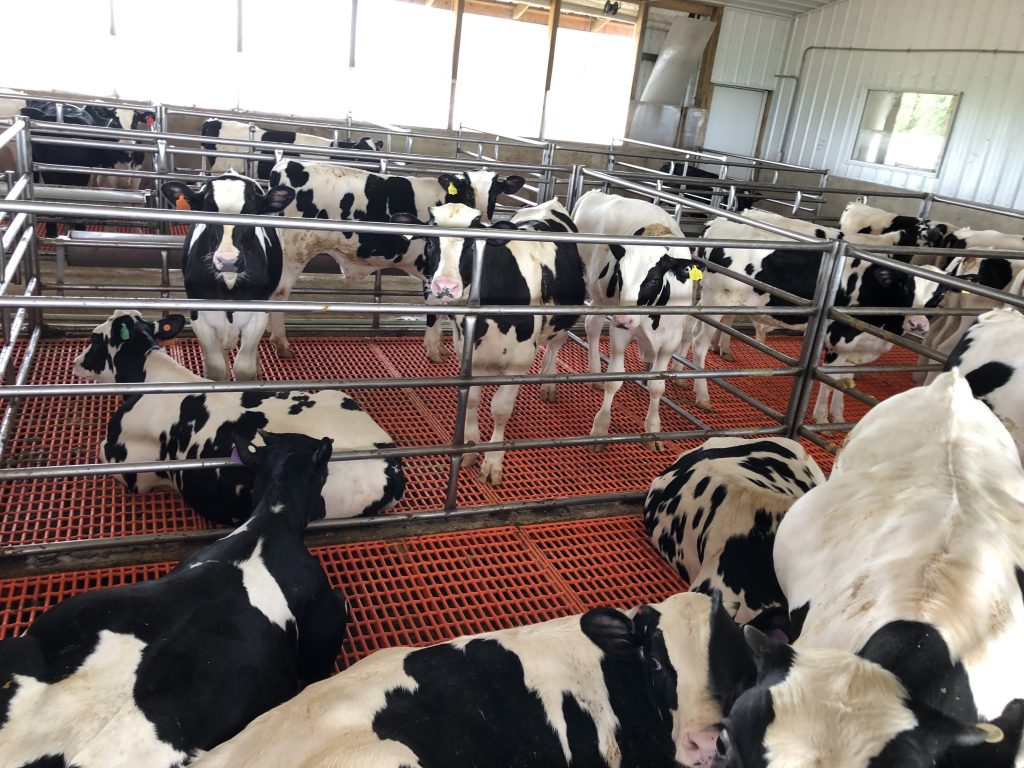
The comfort mats the calves stand on allows for drainage, and helps keep calves and barn clean. Waste is collected and strategically managed for fertilizer.
Is veal baby cows? A 500-pound cow is probably not what you think of when you think “baby cows”. If you feel that way, consider the numbers: Veal calves are about 24 weeks old and 500 pounds when harvested. On the other hand, broiler chickens are 6 weeks old when slaughtered (they are 24 when they reach sexual maturity). Do you eat think “I’m eating baby chicken” when you eat chicken?
Veal Nutrition
Veal is an excellent source of protein. A 3-ounce portion provides about 27 grams of protein and only 170 calories. It provides other key nutrients as well (vitamin B-6, vitamin B-12, niacin, riboflavin, zinc, selenium and choline). Lean veal cuts (such as cutlets or loin chops) can easily be included in a healthy balanced diet (like the DASH Diet plan or Mediterranean style diet). These dietary plans allow for small amounts of lean meats like veal, beef and pork, as well as moderate amounts of poultry and fish.
If you are calorie-conscious, veal can be a great way to create high protein meals. Eggs, peanuts, or other plant-based proteins are great to include in your diet but look at the calorie difference when you compare 27-grams of veal protein to some other protein sources:
|
Protein Source |
Grams of protein |
Calories |
|
3 ounces lean veal |
27 |
170 |
|
4 large eggs |
28 |
300 |
|
3/4 cup peanuts |
27 |
620 |
|
8 TB almond butter |
27 |
780 |
Cooking with Veal
I encourage you to give Veal a try. From a culinary perspective, veal is a specialty meat that’s flavorful and unique. The meat is firm and tender with a creamy pink color.
Adding ground veal to your meatballs or meatloaf, for instance, will definitely kick them up a notch. I made these delicious veal meatballs with all ground veal, but you can also do part veal, part ground beef and/or pork. You can find my bleu cheese pasta recipe here.
Grilling chops is easy! These grilled chops were also a big hit with my family. I simply seasoned the chops with crushed garlic, salt and pepper, brushed with olive oil, then grill them for about 4-5 minutes per side.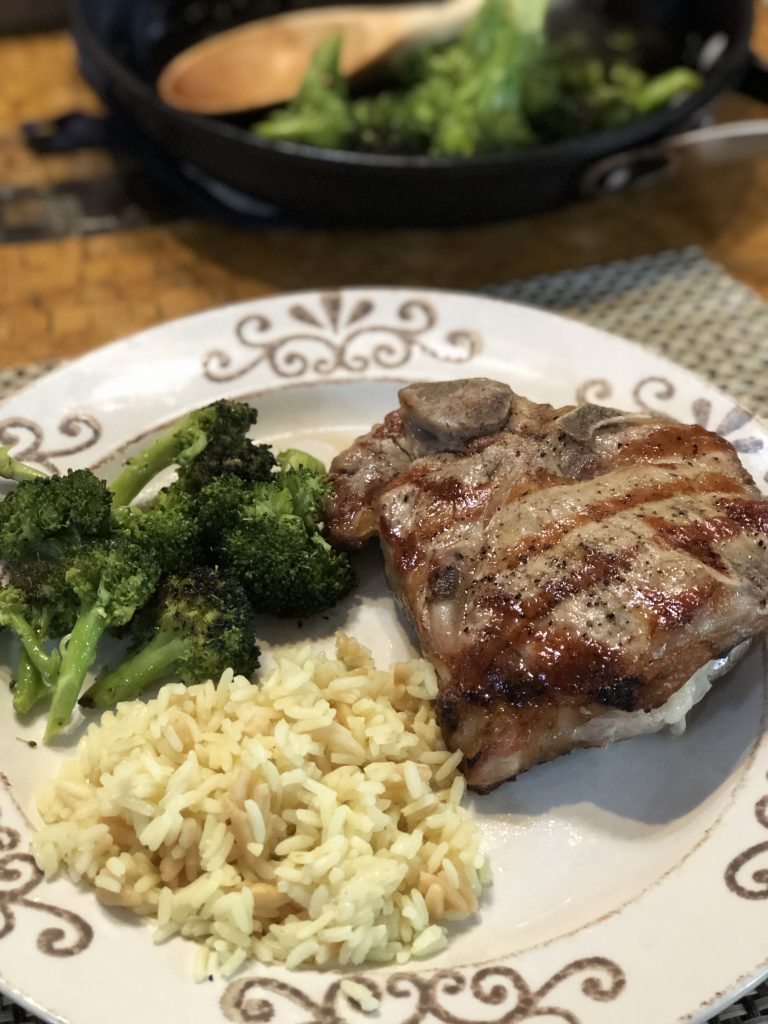
Learn more here about cooking with veal, and visit this page to learn more about the industry.
